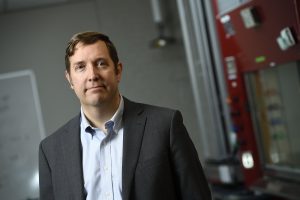
Michael Kessler hit the Johns Hopkins campus running in January and hasn’t slowed down since. An expert in mechanics, processing, and characterization of polymer matrix composites and nanocomposites, the new head of the Department of Materials Science and Engineering has been getting to know faculty, staff, and students, getting up to speed on administrative procedures, and—surprisingly—brushing up on his soccer game.
“There’s a group of students that plays pickup soccer up at the Rec Center several times a week. When I can, I like to go up there and join them, and they’ve been gracious enough to let an old guy play,” Kessler says.
But even scoring a goal in one of those games cannot distract him from his mission: taking a department from excellence to preeminence.
We sat down recently with the new head to discuss his background, goals, and vision.
Why Hopkins?
Hopkins is the top research university in the world and a place where the very leading edge of science is happening. As a department head, I have an opportunity to lead one of the top material science and engineering departments in the world and help take it even further by working with our faculty to set a vision and goals. Materials are so fundamental to all technology and what we choose to invest in has a great potential to really impact the field.
Talk about your vision for the department
At a recent leadership meeting for the School of Engineering, Dean Ed Schlessinger talked about what he called “the path to preeminence.” Preeminence is the Whiting School’s goal. In alignment with that, my vision is for the department to be preeminent. That means having the very best faculty and the very best students and doing the very best science. We have real opportunities to grow our educational offerings in biomaterials science and engineering, and I plan to take that forward by working with our faculty to grow research and educational offerings in that area. We also have notable strength in artificial intelligence as it applies to materials, as well as the Materials Characterization and Processing facility and the capabilities of big data to really accelerate the discovery of new materials. Sustainable energy is a big priority in [the Whiting School of Engineering]. The properties and performance of materials is really the critical piece to achieving sustainable energy advances. Those are all areas where we can advance our vision to become preeminent.
What experience do you bring to this role?
I studied mechanical engineering at LeTourneau University in Longview, Texas for undergrad. I had some very inspirational professors—one particularly who taught solid mechanics and materials courses. After seeing what he was doing, I said, “I think I’d like to do that.” So, I went to graduate school at the University of Illinois, where I pursued my PhD and studied theoretical and applied mechanics. I fell in love with research at Illinois. I worked on composite materials and self-healing polymers, developing a new paradigm in materials inspired by nature. Right after my PhD, I went to the University of Tulsa as an assistant professor, and three years later moved to Iowa State University. My wife is from Des Moines, so that was a good fit.
At Iowa State, I moved through the ranks from an assistant to associate to full professor, where I led a large research group and found I enjoyed the administrative side of that! So, when there came an opportunity to take that administrative piece to the next level by becoming the director of the School of Mechanical and Materials Engineering at Washington State University in Pullman, Washington, I took it.
I was there for four years before moving to North Dakota State University to be the dean of the College of Engineering. I grew up in South Dakota, so it was sort of coming back to my roots. I did that for the last six years before coming here.
What do you see as some of the most important problems or challenges in your field today?
Most industries, from energy to manufacturing, are limited by the properties and performance of materials. But materials science and the development of new materials are experiencing an unprecedented acceleration. With the advent of high-performance computing and simulation tools, we can now explore vast material design spaces and predict properties with astounding accuracy. Also, the integration of artificial intelligence and machine learning techniques allows us to analyze enormous amounts of data, find patterns, and accelerate materials discovery.
With that acceleration though, one critical issue revolves around sustainability and environmental impact. As the demand for advanced materials grows, finding eco-friendly alternatives and reducing the carbon footprint of the manufacturing process are critical. It is important to explore novel materials with improved properties while minimizing resource consumption and waste. Another big challenge in materials science and engineering is the pursuit of breakthroughs in clean energy generation, storage, and conversion. As renewable energy sources gain prominence, the needs for high-performance batteries and energy storage systems are vital.
The faculty here are prolific in these spaces though and I feel confident that the work they are doing right now is going to inform the future of materials science and engineering.
Anything people should know about you?
Just that I’m extremely happy to be working at Johns Hopkins University. I’m also thrilled to be living in Baltimore. I’ve found the community to be very welcoming, and I must say, the city has truly lived up to its nickname as Charm City. I hope anyone I haven’t met yet will stop by my office and say hello. I’m looking forward to getting to know you.